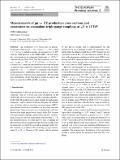| dc.contributor.author | Sirunyan, A. M. | |
| dc.contributor.author | Tumasyan, A. | |
| dc.contributor.author | Adam, W. | |
| dc.contributor.author | Ambrogi, F. | |
| dc.contributor.author | Bergauer, T. | |
| dc.contributor.author | Dragicevic, M. | |
| dc.contributor.author | Erö, J. | |
| dc.contributor.author | Valle, A. E. D. | |
| dc.contributor.author | Frühwirth, R. | |
| dc.contributor.author | Jeitler, M. | |
| dc.contributor.author | Krammer, N. | |
| dc.contributor.author | Lechner, L. | |
| dc.contributor.author | Liko, D. | |
| dc.contributor.author | Madlener, T. | |
| dc.contributor.author | Mikulec, I. | |
| dc.contributor.author | Pitters, F. M. | |
| dc.contributor.author | Rad, N. | |
| dc.contributor.author | Schieck, J. | |
| dc.contributor.author | Schöfbeck, R. | |
| dc.contributor.author | Spanring, M. | |
| dc.date.accessioned | 2021-09-20T17:41:36Z | |
| dc.date.available | 2021-09-20T17:41:36Z | |
| dc.date.issued | 2021-03-01 | |
| dc.identifier.uri | https://hdl.handle.net/1721.1/132040 | |
| dc.description.abstract | Abstract
The production of Z boson pairs in proton–proton (
$${\mathrm{p}} {\mathrm{p}} $$
p
p
) collisions,
$${{\mathrm{p}} {\mathrm{p}} \rightarrow ({\mathrm{Z}}/\gamma ^*)({\mathrm{Z}}/\gamma ^*) \rightarrow 2\ell 2\ell '}$$
p
p
→
(
Z
/
γ
∗
)
(
Z
/
γ
∗
)
→
2
ℓ
2
ℓ
′
, where
$${\ell ,\ell ' = {\mathrm{e}}}$$
ℓ
,
ℓ
′
=
e
or
$${{\upmu }}$$
μ
, is studied at a center-of-mass energy of 13
$$\,\text {TeV}$$
TeV
with the CMS detector at the CERN LHC. The data sample corresponds to an integrated luminosity of 137
$$\,\text {fb}^{-1}$$
fb
-
1
, collected during 2016–2018. The
$${\mathrm{Z}} {\mathrm{Z}} $$
Z
Z
production cross section,
$$\sigma _{\text {tot}} ({\mathrm{p}} {\mathrm{p}} \rightarrow {\mathrm{Z}} {\mathrm{Z}} ) = 17.4 \pm 0.3 \,\text {(stat)} \pm 0.5 \,\text {(syst)} \pm 0.4 \,\text {(theo)} \pm 0.3 \,\text {(lumi)} \text { pb} $$
σ
tot
(
p
p
→
Z
Z
)
=
17.4
±
0.3
(stat)
±
0.5
(syst)
±
0.4
(theo)
±
0.3
(lumi) pb
, measured for events with two pairs of opposite-sign, same-flavor leptons produced in the mass region
$${60< m_{\ell ^+\ell ^-} < 120\,\text {GeV}}$$
60
<
m
ℓ
+
ℓ
-
<
120
GeV
is consistent with standard model predictions. Differential cross sections are also measured and agree with theoretical predictions. The invariant mass distribution of the four-lepton system is used to set limits on anomalous
$${\mathrm{Z}} {\mathrm{Z}} {\mathrm{Z}} $$
Z
Z
Z
and
$${{\mathrm{Z}} {\mathrm{Z}} \gamma }$$
Z
Z
γ
couplings. | en_US |
| dc.publisher | Springer Berlin Heidelberg | en_US |
| dc.relation.isversionof | https://doi.org/10.1140/epjc/s10052-020-08817-8 | en_US |
| dc.rights | Creative Commons Attribution | en_US |
| dc.rights.uri | https://creativecommons.org/licenses/by/4.0/ | en_US |
| dc.source | Springer Berlin Heidelberg | en_US |
| dc.title | Measurements of $${\mathrm{p}} {\mathrm{p}} \rightarrow {\mathrm{Z}} {\mathrm{Z}} $$ p p → Z Z production cross sections and constraints on anomalous triple gauge couplings at $$\sqrt{s} = 13\,\text {TeV} $$ s = 13 TeV | en_US |
| dc.type | Article | en_US |
| dc.identifier.citation | The European Physical Journal C. 2021 Mar 01;81(3):200 | en_US |
| dc.contributor.department | Massachusetts Institute of Technology. Department of Physics | |
| dc.identifier.mitlicense | PUBLISHER_CC | |
| dc.eprint.version | Final published version | en_US |
| dc.type.uri | http://purl.org/eprint/type/JournalArticle | en_US |
| eprint.status | http://purl.org/eprint/status/PeerReviewed | en_US |
| dc.date.updated | 2021-03-07T05:50:35Z | |
| dc.language.rfc3066 | en | |
| dc.rights.holder | CERN for the benefit of the CMS collaboration | |
| dspace.embargo.terms | N | |
| dspace.date.submission | 2021-03-07T05:50:35Z | |
| mit.license | PUBLISHER_CC | |
| mit.metadata.status | Authority Work and Publication Information Needed | |
